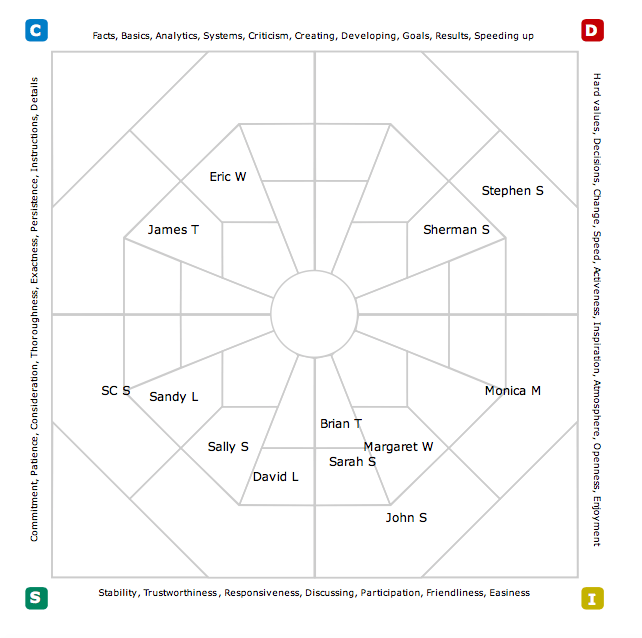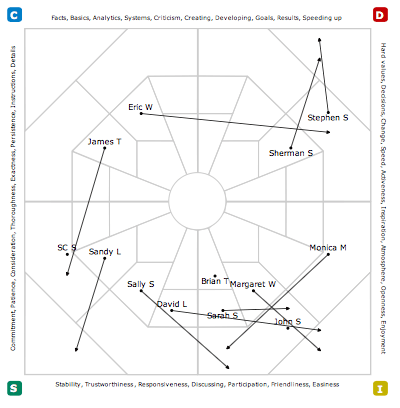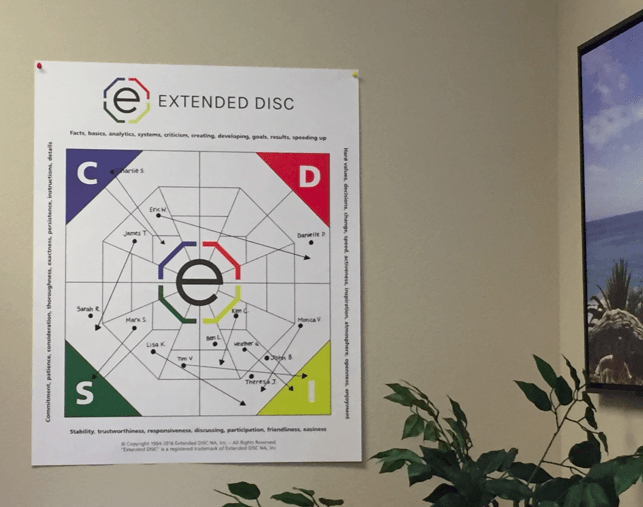Every coach of a sports team has a playbook designed to guide his/her players to success. Wouldn't it be great if you had a Manager's Playbook for leading your team?
The team DISC Assessment is a widely used DISC tool. As the name implies, we often use it for working with teams. However, we are seeing more and more how managers can use team assessments to manage and develop their teams. We are looking at similar information, but from a different viewpoint using the Manager's Playbook.
Starting with the Individual DISC Report
The first step is to start at the individual level by having each team member complete the DISC Assessment. From that, you can print many kinds of DISC reports including Sales, Standard, Leaders, etc. Your team member receives a tailored DISC report in order to develop better awareness of self. What are our own preferred ways of doing things?
Coaches and managers can help the person understand his/her DISC profile type and how they can improve their daily interactions. The DISC report provides a lot of actionable information which can be more useful in effective change.
Progressing to the Manager's Report
A possible next step still focuses on the individual, but from the manager's viewpoint. For example, you could print the Sales Assessment for the Manager. Managers and coaches can use the report to help support the person become more effective in their interactions. You can identify and help your employee better understand his/her strengths, motivators, communication style, etc.
Your employee takes one, and only one, DISC test and from that you can generate as many different reports as you need. That's the best part of our DISC tool.
What is the Manager's Playbook?
 We take all the team members' individual results and create the team report. This Team DISC Assessment is not designed for the team, but for the manager. However, there are similar sections and graphs to the standard team report.
We take all the team members' individual results and create the team report. This Team DISC Assessment is not designed for the team, but for the manager. However, there are similar sections and graphs to the standard team report.
We call this the Manager's Playbook because we find that many managers keep it close at hand and refer back to it often. The idea is that you have accessible and quick information to refer to when meeting one-on-one and in team meetings.
It's a constant reminder to modify your leadership behaviors as much as you can. Sections of the report include how to better communicate with your team and how to motivate your team. In addition, the report highlights what type of management style would best match each employee.
Our Pressures as a Manager
Managers tend to become focused on daily routines and become very task-oriented. We may start the day with a clear agenda and the energy to accomplish our goal, but then things happen. We find that our clear agenda gets pushed aside with problems that pop up or opportunities that we didn't anticipate. How can we let great chances slip right by? We can't.
So at the end of the day, we end up entangled between these diversions and we lose sight of what we need to do to be more effective as leaders. Our success is not measured by how we contribute as an individual, but it's how well my team and department performs. It is up to us, as managers, to develop our employees to be able to succeed and achieve goals and generate results. The Manager's Playbook helps us stay focused on the big picture and overall plan.
Where to Start with the Manager's Playbook?
 The Name Map is a great place to start to elevate the performance of the team. Managers will view the Manager's Report differently from the team members. Team members and managers have different motivators and viewpoints. Hence, the meaning of the data will be different as well. Managers may not find the Shotgun Map as helpful since they already know where their employees' natural DISC styles are. As a manager or coach, you want to know what kinds of styles you have on your team.
The Name Map is a great place to start to elevate the performance of the team. Managers will view the Manager's Report differently from the team members. Team members and managers have different motivators and viewpoints. Hence, the meaning of the data will be different as well. Managers may not find the Shotgun Map as helpful since they already know where their employees' natural DISC styles are. As a manager or coach, you want to know what kinds of styles you have on your team.
Do you have groupings of DISC styles within your team? Are there areas on the Name Map that do not have team members? It's all about the context. Lack of team members in a DISC quadrant is only a weakness if those DISC behaviors are required for the team to succeed.
Using Other Sections of the Manager's Playbook
Your Team at a Glance section quickly reminds you each of the attributes of your team members. It can remind you that each team member requires an adjustment of your leadership style and also reminds you to avoid treating everyone the same way. Attributes are a way to visualize the DISC style of a person. Use this section as a quick reference guide to remind yourself of your team members' DISC styles.
Managers can use the How to Manage Your Team section to manage expectations of what your team members need from you as a manager. What is my ideal leadership style with each of my employees? This is a good reminder of ways to adjust my leadership style to best manage each of my employees. Managers who are fluent in the language of DISC still need specific tips on how to adjust their behaviors with each employee. It's much faster to refer to this section than going back and reading a full DISC report.
Once managers know how they can better manage different employees, then they can move on. Managers can use the How to Motivate Your Team section to identify what motivates each of their employees. Again, it's a quick reference card for your team.
Manager's Playbook Behavioral Dimensions
There are over 2000 behavioral dimensions that are available in the Manager's Playbook. Managers can visually see and compare how comfortable or not comfortable employees are with certain behaviors. Remember the DISC report including these behaviors are not about one's ability, but energy level. If certain behaviors are more natural for an employee it doesn't mean that it's a good thing. It could even be a liability if it's overused or not appropriate for the role.
These graphs lay out how the entire team shows up on behaviors that are important to the team's success. It's quick, easily accessible, and highly usable. We find that if we overload managers with information then there's a good chance they won't use it.
Visualizing Team Pressures in the Manager's Playbook
 Look at the Arrow Map from the viewpoint of the manager because the interpretation will be different. The arrows for team member reflects how they feel they would need to adjust their natural DISC style to succeed in their present environment.
Look at the Arrow Map from the viewpoint of the manager because the interpretation will be different. The arrows for team member reflects how they feel they would need to adjust their natural DISC style to succeed in their present environment.
The are different pressures that will influence the direction of the arrows, but the number one pressure is most likely the manager. The manager is the one who evaluates and sets the expectations and goals. Employees feel driven to be successful in the eyes of their managers.
So managers need to look at these adjustments carefully. Are the directions of the arrows what they expected and wanted them to be? Why do my employees feel these adjustments create success?
Therefore, managers first need to have a clear vision of what they want to achieve. If managers don't have that clear vision then it may be reflected in the arrows. The arrows may go every which way.
Am I the Problem and How Can I Change That?
Managers may bring in trainers or consultants to help address team issues. They may automatically assume the problem is with the team. Team members need help with something they are doing wrong. Managers may be the problem if they are not providing clear goals and expectations.
The Manager's Playbook provides clear data and helps managers manage the team as a whole. If managers have this information they can better understand their team and give better big picture guidance. Managers can use the Manager's Playbook to better support and develop each team member. In addition, they can use it to support and develop the team as a whole.
Reinforcing Success Using DISC

A great way to reinforce DISC for managers is to display their team's DISC Diamond Map in their offices. It's a quick and constant reminder for managers to adjust their DISC styles for different employees.
DISC needs to become part of the organizational culture. When managers put this visual chart on their walls it shows the team that DISC is important. Employees who see the Arrows Map prominently displayed on their manager's wall will realize that their boss values DISC and therefore, they need to as well. In addition, other managers will see the team map and also want to use it to gain the competitive edge. This is a simple and visual method to build DISC into the organizational culture.
There are many ways to become a more effective manager. The Manager's Playbook is one great tool to do just that.
